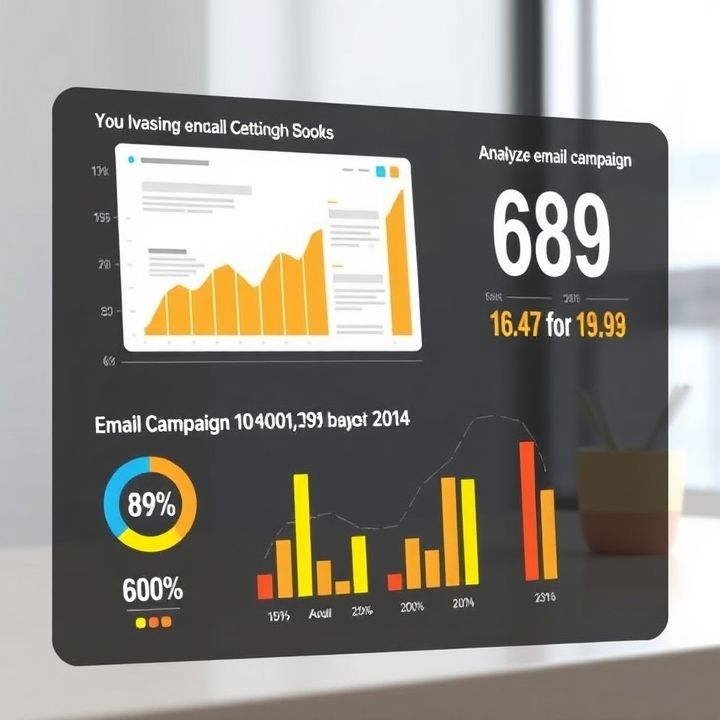Table of Contents
- Introduction
- Analyze Unsubscribe Reasons to Improve Content
- Provide an Easy and Clear Unsubscribe Option
- Segment Your Audience for Targeted Emails
- Offer Alternatives to Unsubscribing
- Conduct A/B Testing for Email Campaigns
- Ensure Relevant and Valuable Content
- Personalize Emails to Increase Engagement
- Monitor and Respond to Feedback
- Conclusion
- Frequently Asked Questions
Introduction
Are you tired of seeing your email subscribers slip away like sand through your fingers? You’re not alone. In the bustling world of email marketing, one of the biggest challenges is retaining subscribers and reducing unsubscribes. But fear not, for we have unearthed some proven strategies that could be the secret to your success!
Imagine turning your email campaigns into a magnet that not only attracts but also retains your audience. It’s not just a dream; it’s a scientifically backed reality. In this article, we unveil key strategies used by the top marketers in the industry. Ready to discover the secrets?
Here’s a sneak peek of what’s to come:
| Strategy | Benefit |
|---|---|
| Personalization | Increases engagement |
| Segmentation | Targets specific interests |
| A/B Testing | Optimizes campaign performance |
Intrigued? Let’s dive in and revolutionize your email marketing campaigns!
Analyze Unsubscribe Reasons to Improve Content
Understanding the reasons behind email unsubscribes is crucial for improving your content and retaining subscribers. First, implement an exit survey that asks users why they are leaving. This can provide invaluable insights into their motivations, whether it’s too many emails, irrelevant content, or poor design. By categorizing this feedback, you can identify common issues that need to be addressed.
Next, dive into your email analytics to spot trends. Look at metrics such as open rates, click-through rates, and the times when unsubscribes spike. These data points can help you assess which types of emails or subjects lead to higher unsubscribe rates.
Regularly update and segment your email list. Ensure that your subscribers are receiving content relevant to their interests and preferences. Personalization can significantly reduce the likelihood of unsubscribes. Additionally, consider offering a frequency preference option, allowing subscribers to choose how often they wish to hear from you.
Lastly, continually test and optimize your email campaigns. A/B testing different elements such as subject lines, content format, and call-to-action buttons can help you find the most effective strategies. By regularly reviewing and responding to feedback and data, you can create more engaging and tailored content that keeps your audience interested and subscribed.
Provide an Easy and Clear Unsubscribe Option
Providing an easy and clear unsubscribe option is crucial for maintaining a positive relationship with your email subscribers. Not only is it a legal requirement under various regulations like GDPR and CAN-SPAM, but it also shows respect for your audience’s preferences. To make the unsubscribe process straightforward, include a clearly visible unsubscribe link in every email, preferably at both the top and bottom for ease of access. This link should lead to a simple, one-click unsubscribe process without requiring the user to log in or navigate through multiple pages.
In addition to the unsubscribe link, offering options to manage email preferences can help mitigate complete unsubscribes. For example, allow subscribers to choose the frequency of emails or the specific types of content they wish to receive. This can be done through a preferences center linked from the unsubscribe page. Ensuring that the unsubscribe process is hassle-free not only complies with regulatory standards but also enhances user trust and improves the overall health of your email list by keeping only engaged subscribers.
Segment Your Audience for Targeted Emails
Segmenting your audience for targeted emails is a crucial step in handling email unsubscribes and reducing their occurrence. By dividing your email list into smaller, more manageable segments based on specific criteria such as demographics, purchase history, or engagement level, you can tailor your content to better meet the needs and interests of each group. This targeted approach ensures that your emails are relevant to the recipients, making them more likely to engage with your content rather than opting out.
Begin by analyzing your existing data to identify key segments within your audience. Common categories include age, location, gender, past purchases, and engagement metrics such as open and click-through rates. Once you have your segments, create customized email campaigns that speak directly to the interests and behaviors of each group. For example, you might send personalized product recommendations to frequent buyers or offer exclusive discounts to loyal customers.
Additionally, regularly review and update your segments to reflect any changes in your audience’s preferences or demographics. This dynamic approach ensures that your emails remain relevant and compelling, thereby reducing the likelihood of unsubscribes and fostering stronger relationships with your subscribers.
Offer Alternatives to Unsubscribing
One effective strategy to handle email unsubscribes is to offer alternatives. Instead of a simple unsubscribe option, provide recipients with choices to better tailor their email experience. For instance, you could offer options like reducing the frequency of emails or choosing specific topics of interest. This not only helps retain subscribers but also ensures they receive content that is more relevant to them.
Another alternative is to enable subscribers to pause their subscription for a certain period. Sometimes, people get overwhelmed with emails and may appreciate a temporary break rather than severing the connection entirely. Additionally, make sure to highlight the value of staying subscribed by reminding them of the exclusive content, offers, or updates they might miss.
It’s also beneficial to include a preference center link in your emails, where subscribers can easily adjust their settings. Making these adjustments user-friendly enhances the subscriber’s experience and reduces the likelihood of them opting out completely. By offering these alternatives, you can improve retention rates and maintain a more engaged audience.
Conduct A/B Testing for Email Campaigns
Conducting A/B testing for email campaigns is a crucial strategy for optimizing engagement and reducing unsubscribe rates. A/B testing, also known as split testing, involves creating two variations of an email to see which one performs better. By testing different elements such as subject lines, email content, call-to-action buttons, and layouts, marketers can gather data on what resonates most with their audience.
To begin, divide your email list into two equal segments and send each group a different version of your email. Monitor the performance metrics like open rates, click-through rates, and, importantly, unsubscribe rates. This data will provide insights into what content or format your audience prefers.
It is essential to change only one element at a time to understand its specific impact. For example, if testing subject lines, keep the email content identical for both groups. After collecting sufficient data, analyze the results to determine the more effective version. Implementing these findings in future campaigns can lead to improved engagement and a reduction in unsubscribes.
Regular A/B testing allows you to stay responsive to your audience’s preferences and continuously refine your email marketing strategy.
Ensure Relevant and Valuable Content
One of the most effective ways to handle email unsubscribes is to ensure that your content is always relevant and valuable to your audience. Irrelevant or low-value emails are prime reasons why subscribers hit the unsubscribe button. To keep your audience engaged, make sure to segment your email list based on various criteria such as interests, past interactions, and purchasing behavior. This allows you to tailor your content to different segments, ensuring that each email is pertinent to its recipients.
Additionally, offering exclusive content, discounts, or early access to products can add value to your emails and make subscribers look forward to receiving them. Regularly analyzing engagement metrics like open rates, click-through rates, and conversion rates can provide insights into what your audience finds valuable. Use this data to continually refine your content strategy.
It’s also beneficial to ask for feedback directly from your subscribers. Simple surveys or feedback forms can provide valuable insights into what your audience likes or dislikes about your emails. By focusing on delivering high-quality, relevant content, you can significantly reduce the number of unsubscribes while building a more engaged and loyal subscriber base.
Personalize Emails to Increase Engagement
Personalizing emails can significantly boost engagement and reduce unsubscribe rates. By tailoring your content to meet the individual preferences and behaviors of your recipients, you create a more relevant and compelling experience. Start by using the recipient’s name in the subject line and greeting, making the email feel more personal and less generic. Leverage data analytics to segment your audience based on demographics, past interactions, and purchase history, allowing you to send targeted content that resonates with each group. Additionally, consider behavior-triggered emails, such as cart abandonment reminders or product recommendations, which directly align with the recipient’s actions.
Including personalized content, such as custom offers and relevant articles, helps maintain interest and demonstrates that you understand your audience’s needs and preferences. Remember to keep the tone conversational and engaging, as this can make your emails more enjoyable to read and encourage ongoing interaction. By incorporating these personalization strategies, you not only improve the overall effectiveness of your email campaigns but also foster a stronger relationship with your subscribers, ultimately reducing the likelihood of unsubscribes.
Monitor and Respond to Feedback
Monitoring and responding to feedback is a critical aspect of handling email unsubscribes effectively. Start by regularly reviewing the reasons why subscribers are opting out of your email lists. Common reasons could include receiving too many emails, irrelevant content, or a general lack of interest. By closely monitoring these trends, you can gain valuable insights into where your email marketing strategy might be falling short.
Responding to feedback should be a proactive process. When a subscriber chooses to unsubscribe, consider offering them the option to select the type of content they prefer or the frequency of emails. This can help retain those who might be overwhelmed but still interested in your offerings. Additionally, sending a follow-up email asking for feedback on why they chose to unsubscribe can provide actionable insights.
Make sure to address any recurring issues promptly. If you notice a pattern, such as complaints about too many emails, consider adjusting your email frequency. Listening to your audience and making the necessary adjustments not only helps reduce the rate of unsubscribes but also improves overall customer satisfaction and engagement.
Conclusion
In conclusion, stopping email unsubscribes involves a comprehensive approach that prioritizes understanding your audience’s needs and preferences. By analyzing unsubscribe reasons, providing clear unsubscribe options, segmenting your audience, and offering alternatives, you can significantly reduce unsubscribe rates. Additionally, conducting A/B testing, ensuring relevant content, personalizing emails, and actively monitoring feedback are pivotal strategies for maintaining a robust and engaged subscriber list. These proven methods not only comply with legal regulations but also enhance user trust and satisfaction, thereby fostering a loyal and engaged audience. Make these strategies an integral part of your email marketing efforts to keep your subscribers engaged and your email list healthy.

